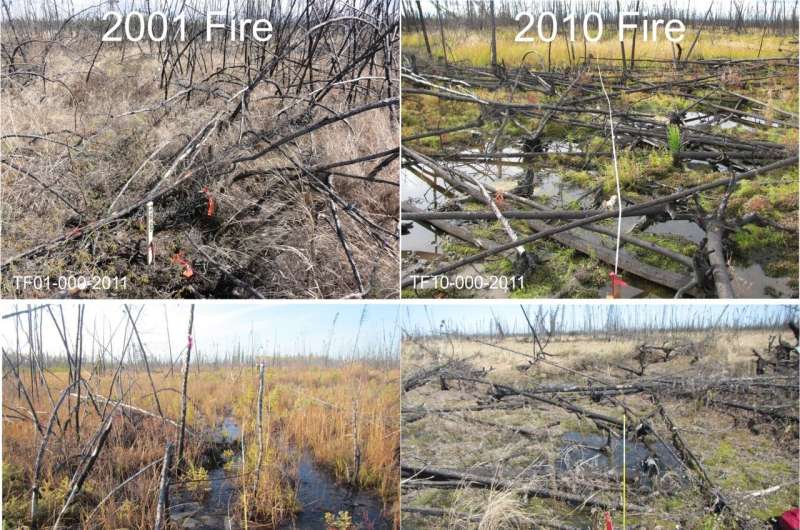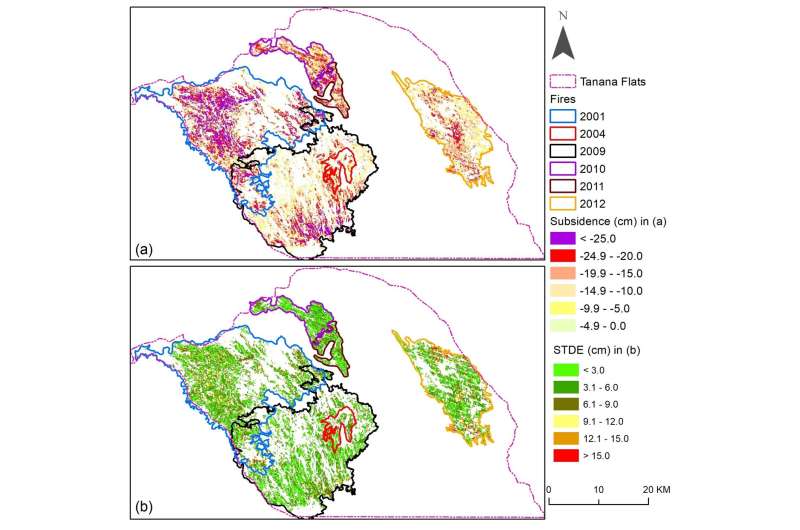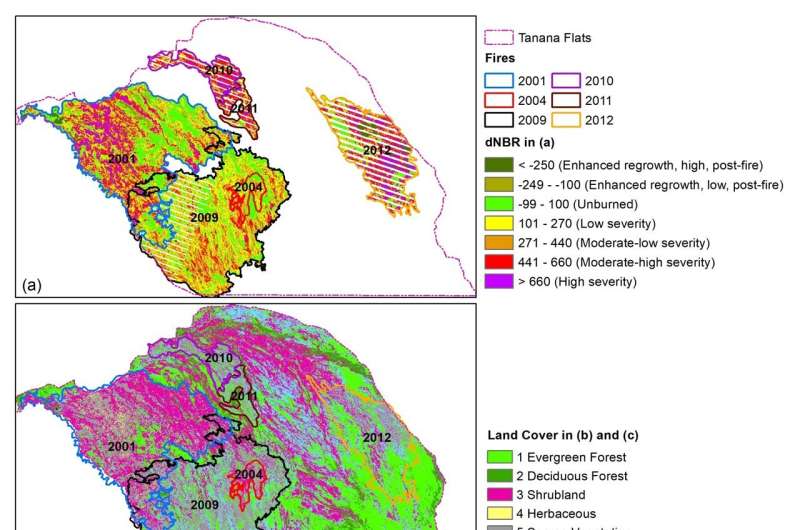This article has been reviewed according to Science X's editorial process and policies. Editors have highlighted the following attributes while ensuring the content's credibility:
fact-checked
peer-reviewed publication
trusted source
proofread
New technique maps large-scale impacts of fire-induced permafrost thaw in Alaska

About 40 percent of interior Alaska is underlain by ice-rich permafrost—permanently frozen grounds made up of soil, gravel and sand—bound together by ice. Certain conditions, such as climate warming, have intensified tundra wildfires which have profound implications for permafrost thaw.
Surface vegetation plays a dominant role in protecting permafrost from summer warmth, so any alteration of vegetation structure, particularly following severe wildfires, can cause dramatic top–down thaw.
Severe wildfires remove the vegetation and surface soil organic matter, and the loss of this insulation increases the ground heat flux and promotes permafrost thaw. This thaw triggers ground sinking and thermokarst (ground-surface collapse from permafrost thaw) development and leads to surface water inundation, vegetation shifts, changes in soil carbon balance and carbon emissions, all impacting climate warming.
The permafrost–fire–climate system has been a hotspot in research for decades. The large-scale effects of these wildfires on land cover change, post-fire resilience, and subsequent thaw settlement remain unknown. Thaw settlement is difficult to measure as there are often no absolute reference frames to compare to the subtle, but widespread topographic change in permafrost landscapes.
Researchers from Florida Atlantic University, in collaboration with the United States Army Corps of Engineers Cold Regions Research & Engineering Laboratory, and Alaska Ecoscience, systematically analyzed the effects of six large fires that have occurred since 2000 on the Tanana Flats lowland in interior Alaska on land cover change, vegetation dynamics, and terrain subsidence, or sinking.

For the first time, they have developed a machine learning-based ensemble approach to quantify fire-induced thaw settlement across the entire Tanana Flats, which encompasses more than 3 million acres (approximately 1,250 km2). Researchers linked airborne repeat lidar data to time-series Landsat products (satellite images) to delineate thaw settlement patterns across the six fire scars. This novel approach helped to explain about 65 percent of the variance in lidar-detected elevation change.
Study findings, published in Environmental Research Letters, showed that in total, the six fires resulted in a loss of nearly 99,000 acres (approximately 400 km2) of evergreen forest from 2000 to 2014 among nearly 155,000 acres (approximately 590 km2) of fire-influenced forests with varying degrees of burn severity.
The fires provided favorable conditions for shrub-fen (low-growing shrubs) development, resulting in a comparable post-fire coverage of shrubland and evergreen forest and increasing encroachment of shrubland to areas with sparse vegetation.
Importantly, the researchers did not observe the regrowth of forests after 13 years of the oldest fire in 2001, based on Landsat observations.
"Our study has shown that linking airborne repeat lidar with Landsat products is an encouraging tool for large-scale quantification of fire-induced thaw settlement," said Caiyun Zhang, Ph.D., senior author and a professor in the Department of Geosciences within FAU's Charles E. Schmidt College of Science. "Because airborne lidar measurements are increasingly being made across northern permafrost regions, our method is a valuable means of projecting elevation change across entire fire scars within uniform permafrost-affected landscapes by using data-driven machine learning techniques."

The Tanana Flats, which comprises more than 6 million acres (approximately 2,500 km2), is representative of the lowland landscape south of Fairbanks in interior Alaska. It consists of a complex mosaic of ice-rich permafrost and permafrost free ecosystems and is a hotbed for thermokarst. Much of the land is part of a military training area managed by the U.S. Department of Defense.
For the study, researchers assessed three commonly used machine learning algorithms including artificial neural network, support vector machine, and random forest for fire-induced thaw settlement modeling.
"Machine learning has been extensively applied for modeling in geosciences," said Zhang. "The idea is that each algorithm has its pros and cons, and an ensemble analysis of comparative models can produce a more robust estimation than the application of a single model."
Current and future projected increases in mean annual air temperature, the length of the summer growing season, and the severity and extent of wildfire are expected to lead to an increasingly dominant role of wildfire in permafrost ecosystems.
"Mapping thaw settlement as a result of wildfires is critical since it is associated with subsequent thermokarst development, snow accumulation, hydrology, vegetation shifts, and commensurate changes in the land-atmospheric exchange of water, energy, and greenhouse gases," said Zhang. "The combination of active airborne lidar sensors with passive spaceborne optical sensors will enable scientists to measure widespread and large areas affected by wildfires in cold regions, especially with climate warming and increased fire events."
More information: Caiyun Zhang et al, Linking repeat lidar with Landsat products for large scale quantification of fire-induced permafrost thaw settlement in interior Alaska, Environmental Research Letters (2022). DOI: 10.1088/1748-9326/acabd6
Journal information: Environmental Research Letters
Provided by Florida Atlantic University




















